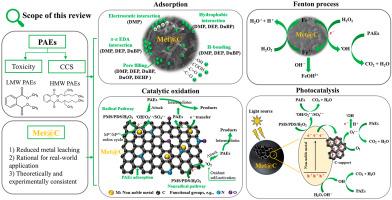Harnessing non-noble metal-doped carbon composites for remediation of phthalate esters contaminated water systems
IF 12
1区 化学
Q1 CHEMISTRY, ANALYTICAL
引用次数: 0
Abstract
Conventional noble metal catalysts exhibit excellent electrical conductivity and catalytic activity; however, their high cost, moderate cyclability, and limited availability render them economically impractical for widespread applications. To solve these problems, non-noble metal-doped carbon (Met@C) composites are highly active, economical, structurally and chemically stable, and have been recommended as next-generation materials for removal of emerging contaminants, such as phthalate esters (PAEs). PAEs are commonly used as plasticizers and categorized as low- and high-molecular weight PAEs to understand their differential acute and chronic toxicological profiles. However, they may leach from plastic products, raising environmental concerns regarding their use. A review of PAEs-Met@C interactions will be helpful for targeted design of Met@C for effective PAEs removal. This paper reviews Met@C and its synthesis and environmental applications, specifically PAEs removal from water via adsorption, activation oxidation, photocatalysis, Fenton/Fenton-like processes, and coupled treatment processes and the mechanisms overlaid. It also discusses factors influencing the performance of Met@C for PAEs removal and degradation. To provide mechanistic insights into degradation kinetics and mechanisms of AOPs for PAEs removal, it describes pseudo-1st-order and 2nd-order rate constants and radical and nonradical species along with density functional theory and molecular dynamics simulations. To address stability, durability, and scalability of Met@C, it thoroughly explores metal leaching, regeneration, and real-world applications of Met@C for PAEs removal. Before conclusions, it overviews perspectives, future challenges, and opportunities for PAEs removal by Met@C. Overall, this review provides a basis for Met@C to solve technique problems in remediation of PAEs contaminated water systems.

利用非贵金属掺杂碳复合材料修复邻苯二甲酸酯污染的水系统
传统贵金属催化剂具有优异的导电性和催化活性;然而,它们的高成本、中等循环性和有限的可用性使得它们在经济上不适合广泛应用。为了解决这些问题,非贵金属掺杂碳(Met@C)复合材料具有高活性、经济、结构和化学稳定性,已被推荐为去除新出现的污染物(如邻苯二甲酸酯(PAEs))的下一代材料。PAEs通常被用作增塑剂,并被分为低分子量PAEs和高分子量PAEs,以了解它们不同的急性和慢性毒理学特征。然而,它们可能会从塑料制品中滤出,引起人们对其使用的环境担忧。回顾PAEs-Met@C相互作用将有助于Met@C有效去除PAEs的目标设计。本文综述了Met@C及其合成和环境应用,重点介绍了吸附法、活化氧化法、光催化法、Fenton/Fenton-like法和耦合处理法去除水中PAEs的方法及其机理。讨论了Met@C对PAEs去除和降解性能的影响因素。通过密度泛函理论和分子动力学模拟,描述了AOPs去除PAEs的准一级和二级速率常数、自由基和非自由基种类。为了解决Met@C的稳定性、耐久性和可扩展性问题,本文深入探讨了Met@C在去除PAEs方面的金属浸出、再生和实际应用。在得出结论之前,通过Met@C概述了PAEs移除的前景、未来的挑战和机遇。综述为Met@C解决PAEs污染水系统的修复技术问题提供了依据。
本文章由计算机程序翻译,如有差异,请以英文原文为准。
求助全文
约1分钟内获得全文
求助全文
来源期刊

Trends in Analytical Chemistry
化学-分析化学
CiteScore
20.00
自引率
4.60%
发文量
257
审稿时长
3.4 months
期刊介绍:
TrAC publishes succinct and critical overviews of recent advancements in analytical chemistry, designed to assist analytical chemists and other users of analytical techniques. These reviews offer excellent, up-to-date, and timely coverage of various topics within analytical chemistry. Encompassing areas such as analytical instrumentation, biomedical analysis, biomolecular analysis, biosensors, chemical analysis, chemometrics, clinical chemistry, drug discovery, environmental analysis and monitoring, food analysis, forensic science, laboratory automation, materials science, metabolomics, pesticide-residue analysis, pharmaceutical analysis, proteomics, surface science, and water analysis and monitoring, these critical reviews provide comprehensive insights for practitioners in the field.
 求助内容:
求助内容: 应助结果提醒方式:
应助结果提醒方式:


